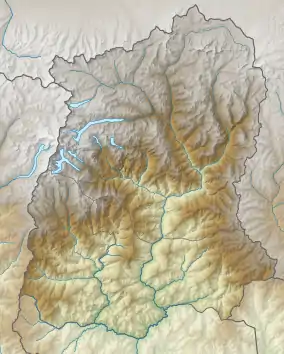Jelep La
Jelep La or Jelep Pass (also spelled Jelap), elevation 4,267 m or 13,999 ft, is a high mountain pass between East Sikkim District, Sikkim, India and Tibet Autonomous Region, China. It is on a route that connects Lhasa to India. The pass is about 4 km (2.5 mi) south of Nathu La and although it is higher, Jelep has been used for centuries by traders because of its less rugged terrain. The Menmecho Lake lies below the Jelep La.
| Jelep La | |
|---|---|
 Jelep La Tibetan Frontier by Nicholas Roerich | |
| Elevation | 4,270 m (14,009 ft) |
| Location | India (Sikkim) – China (Tibet Autonomous Region) |
| Range | Himalaya |
| Coordinates | 27°22′02″N 88°51′57″E |
 | |
| Jelep La | |||||||
|---|---|---|---|---|---|---|---|
| Traditional Chinese | 則里拉山口 | ||||||
| Simplified Chinese | 则里拉山口 | ||||||
| |||||||
Jelep-la, a Tibetan name, means "The lovely level pass, so called because it is the easiest and most level of all the passes between Tibet and Sikkim."[1]
On the Indian side there are two routes to Jelep La, one through Gangtok and the other through Kalimpong. The Kalimpong route is an ancient one which was responsible for the boost in the local economy due to the trading of wool and furs early last century. The pass was closed after the Sino-Indian War in 1962. It passes through the towns of Pedong in northern West Bengal, Rhenok, and Kupup. The route from Gangtok passes through the towns of Sherathang, nearby Changu lake and alongside Nathu La and through Kupup.
The route is scenic with forests of rhododendrons blooming in spring. Numerous hamlets are scattered in the surrounding area. On the Tibetan side the pass leads to the Chumbi Valley of the Tibetan Plateau.
History
Jelep La was in use from early times as trade flourished between India and Tibet. After the appropriation of India by the British, the latter started to construct roads into Sikkim around 1884.[2] This was viewed with some apprehension among the Tibetans and in 1886 a small Tibetan militia occupied the region around the pass. In May 1888, they attacked the British but were warded off by a British Expeditionary Force. Later in September the same year the British regained control of the area around the pass.
With the growing Russian influence in Tibet, a British expedition was sent via Jelep La to Lhasa in 1904 led by Colonel Francis Younghusband. This expedition was met by hostile Tibetan forces which were defeated by the British. A trade agreement was then forced on the Tibetans in the absence of the 13th Dalai Lama, who had fled to Mongolia.
In 1910, to escape a Chinese invasion, the 13th Dalai Lama "accompanied by six ministers and a small escort" which included his close aide, diplomat and military figure Tsarong Dzasa, fled via Jelep La[3] to Sikkim and Darjeeling, where they stayed almost two years. During this period he was invited to Calcutta by the Viceroy, Lord Minto, which helped restore relations with the British.[4]
After India's independence in 1947, Sikkim, which was then a monarchy, agreed to a special protectorate status and gave India the status of a suzerain nation and its defence and foreign affairs were managed by India. After the Chinese invasion of Tibet in 1950 and suppression of the Tibetan uprising in 1959, the passes into Sikkim became a conduit for refugees from Tibet before being closed by the Chinese. During the 1962 Sino-Indian War, there were border skirmishes between the Indian and Chinese armed forces in and around the passes of Jelep La and Nathu La - this was despite Sikkim still being a separate Kingdom at that stage. After the war the two passes were closed.[5][6]
Sikkim became a part of India in early 1975 following a referendum. With the recent thawing in relations between India and China, plans are afoot to reopen the Jelep La (following the July 6, 2006 reopening of the Nathu La) which is projected to result in an economic boom for the region.
References
- O'Malley, L. S. S. (1907). Bengal District Gazetteer : Darjeeling. Concept Publishing Company. p. 215. ISBN 978-81-7268-018-3.
- Paget, William Henry (1907). Frontier and overseas expeditions from India. Indian Army Intelligence Branch. p. 42.
- The Thirteenth Dalai Lama, Thupten Gyatso Archived 2012-09-12 at WebCite, dalailama.com
- Chapman (1940).
- http://articles.economictimes.indiatimes.com/2014-07-25/news/52026486_1_india-bhutan-tibet-trade-route-jelep-la
- http://zeenews.india.com/news/nation/will-india-and-china-fight-a-war-again_801878.html
Further reading
- Harris, Tina (2013). Geographical Diversions: Tibetan Trade, Global Transactions. University of Georgia Press, United States. ISBN 0820345733.